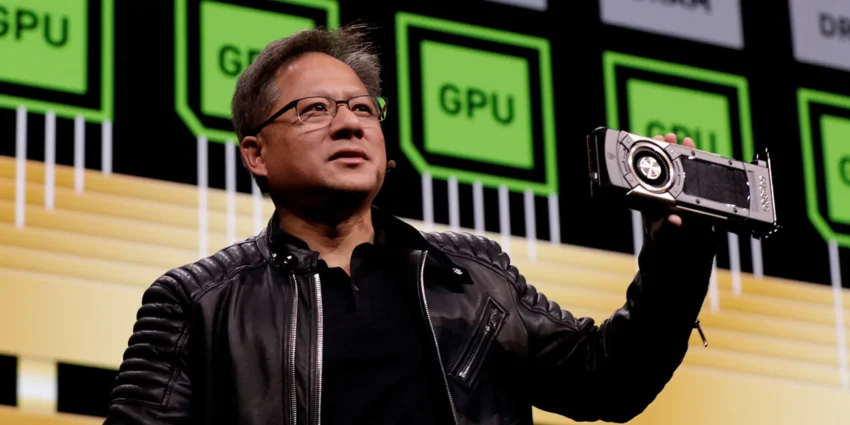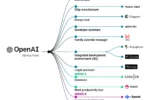Nvidia AI technology leadership has positioned the company at the forefront of innovation in artificial intelligence and semiconductors. Recently, CEO Jensen Huang met with former President Donald Trump to discuss the critical role that U.S. technology policy plays in maintaining this leadership. During their discussion, they emphasized the need to strengthen domestic semiconductor manufacturing in light of potential Trump tariffs on foreign chips, which could significantly impact prices for consumers. The conversation also touched on the bipartisan Chips and Science Act, a pivotal initiative aimed at boosting U.S. chip production and improving economic security. As Nvidia continues to lead in AI development, the outcomes of such discussions could shape the future landscape of technology in America, influencing both local manufacturing and global competitiveness in the semiconductor industry.
In the evolving landscape of artificial intelligence and semiconductor technology, Nvidia stands out as a pioneer, steering the direction of U.S. tech policy. The recent dialogue between Jensen Huang and Donald Trump highlights the urgency to fortify America’s position in these sectors, especially concerning the implications of international tariffs. This meeting comes against the backdrop of the Chips and Science Act, which seeks to reinvigorate domestic chip manufacturing and stimulate economic growth. As the U.S. grapples with the challenges of global competition, Nvidia’s role in leading the charge for innovation and national security becomes increasingly vital. The intersection of AI advancements and semiconductor production is crucial for the future of technology in the United States.
Nvidia’s Role in U.S. AI Technology Leadership
Nvidia has emerged as a pivotal player in the U.S. technology landscape, particularly in artificial intelligence (AI) and semiconductors. The recent meeting between CEO Jensen Huang and President Donald Trump underscores the importance of Nvidia’s leadership in shaping AI policy and strengthening the nation’s technological infrastructure. As AI continues to transform industries, Nvidia’s advancements in GPU technology place it at the forefront of innovation. The company’s commitment to research and development is vital for maintaining U.S. dominance in the global tech arena.
Moreover, Nvidia’s influence extends beyond just AI; it plays a crucial role in the semiconductor supply chain. As discussions around tariffs on foreign semiconductor products intensify, the need for robust domestic manufacturing capabilities becomes clearer. Nvidia’s leadership in AI technology could help guide U.S. policies that foster innovation while mitigating the risks associated with reliance on overseas suppliers. By investing in local manufacturing and R&D, Nvidia can help ensure that the U.S. remains a leader in both semiconductors and AI.
Impact of Trump Tariffs on the Semiconductor Industry
The recent announcement of potential tariffs by President Trump on foreign semiconductor products could have profound implications for the industry. With Trump stating that these tariffs aim to bring semiconductor production back to the U.S., companies like Nvidia are positioned to benefit from increased domestic manufacturing incentives. However, the Consumer Technology Association warns that such tariffs could lead to significant price hikes on consumer electronics, straining the budgets of American families. If implemented, these tariffs could disrupt the delicate balance of supply and demand in the semiconductor market.
In response to the proposed tariffs, industry leaders are advocating for a focus on incentives rather than penalties. The Chips and Science Act, which allocates $52 billion in subsidies, serves as a critical component in enhancing U.S. competitiveness. By encouraging companies to invest in domestic chip manufacturing, the act is designed to stimulate job creation and economic growth. The ongoing dialogue between tech companies and government officials highlights the need for a strategic approach that prioritizes long-term sustainability over short-term solutions.
The Chips and Science Act: A Catalyst for Growth
The Chips and Science Act represents a significant legislative step toward revitalizing the American semiconductor industry. With $52 billion allocated for subsidies, the act aims to encourage companies like Intel and TSMC to establish manufacturing facilities in the U.S. This initiative is essential not only for creating jobs but also for enhancing national security by reducing dependence on foreign semiconductor production. As seen from recent investments, the act is already spurring substantial financial commitments from key players in the semiconductor ecosystem.
Furthermore, the Chips and Science Act has the potential to triple U.S. semiconductor manufacturing capacity by 2032. This forecast aligns with the growing demand for chips in various industries, including AI, automotive, and consumer electronics. By fostering a robust domestic semiconductor supply chain, the U.S. can ensure its technological advancements remain competitive globally. As more companies announce projects and investments in response to the act, it is clear that this legislation will play a pivotal role in shaping the future of the American tech industry.
Jensen Huang’s Vision for AI and Semiconductors
Jensen Huang, as the CEO of Nvidia, has consistently advocated for the importance of AI and semiconductors in driving the next wave of technological innovation. His recent discussions with President Trump highlight a shared vision for enhancing U.S. leadership in these critical areas. Huang’s leadership in AI technology has positioned Nvidia as a frontrunner in developing solutions that optimize various sectors, from healthcare to entertainment. His insights into the future of semiconductors are instrumental in guiding U.S. tech policy.
Moreover, Huang’s emphasis on collaboration between the private sector and government is crucial for addressing the challenges posed by global competition. As tariffs threaten to disrupt the semiconductor supply chain, Huang’s focus on innovation and investment in domestic capabilities can help mitigate these risks. By fostering partnerships and promoting policies that support the semiconductor industry, Huang aims to ensure that America remains at the forefront of technological advancements.
US Tech Policy and Semiconductor Manufacturing
The landscape of U.S. tech policy is rapidly evolving as lawmakers and industry leaders grapple with the implications of global supply chain disruptions. The semiconductor industry is at the heart of these discussions, especially with the introduction of tariffs and new policies aimed at boosting domestic production. Companies like Nvidia are advocating for a balanced approach that emphasizes innovation and investment over punitive measures. U.S. tech policy must adapt to the changing environment to ensure that American manufacturers can compete effectively on a global scale.
In addition, the bipartisan support for the Chips and Science Act reflects a collective recognition of the strategic importance of semiconductor manufacturing. By providing financial incentives, the U.S. government aims to create a favorable environment for companies to invest in domestic production. This shift in policy not only addresses immediate supply chain concerns but also lays the groundwork for long-term growth in the semiconductor sector. As U.S. tech policy evolves, it is essential to keep the focus on fostering innovation and maintaining a competitive edge.
The Future of Semiconductor Investments in America
As the semiconductor landscape continues to shift, the future of investments in America looks promising due to targeted government initiatives like the Chips and Science Act. This act has already led to announcements of numerous projects aimed at bolstering the domestic semiconductor ecosystem. With projections indicating a tripling of manufacturing capacity by 2032, the U.S. is poised to reclaim its position as a leader in semiconductor production. These investments will not only create jobs but also drive economic growth across various sectors.
Moreover, the increasing focus on semiconductor investments aligns with the growing demand for chips in emerging technologies such as AI, 5G, and autonomous vehicles. Companies are responding to this demand by committing billions of dollars to new projects, signifying a robust recovery and expansion within the industry. By prioritizing domestic manufacturing and innovation, the U.S. can enhance its technological capabilities and ensure a sustainable supply chain for the future.
Global Competition in Semiconductor Production
The competition in global semiconductor production is intensifying as nations recognize the strategic importance of chip manufacturing. Countries like Taiwan have dominated the semiconductor market, accounting for a significant share of global production. In response to this challenge, U.S. tech policy is shifting to encourage domestic manufacturing through initiatives like the Chips and Science Act. By fostering a competitive environment, the U.S. aims to reduce its reliance on foreign suppliers and strengthen its position in the global market.
Additionally, the ongoing geopolitical tensions and trade disputes further highlight the need for a robust domestic semiconductor industry. As tariffs on foreign semiconductor products are considered, the U.S. must prioritize investments that promote self-sufficiency. By supporting companies that invest in U.S. manufacturing capabilities, the government can help secure the country’s technological future while fostering innovation and economic growth.
Economic Implications of Semiconductor Tariffs
The proposed semiconductor tariffs by the Trump administration could have far-reaching economic implications. While aimed at protecting domestic manufacturers, these tariffs may inadvertently increase consumer prices for essential electronics. The Consumer Technology Association has warned that tariffs could lead to significant price hikes on products like laptops, smartphones, and game consoles. Such increases could strain the budgets of American consumers, potentially stifling demand and slowing economic growth.
Moreover, the potential long-term effects of these tariffs on the semiconductor industry are concerning. While the intention is to bring manufacturing back to the U.S., the immediate consequences could result in supply chain disruptions and increased costs for manufacturers. It is crucial for policymakers to carefully evaluate the potential trade-offs associated with these tariffs and consider alternative approaches that incentivize domestic production without placing undue burden on consumers and businesses alike.
Navigating the Challenges of Semiconductor Supply Chains
Navigating the challenges of semiconductor supply chains has become increasingly complex in recent years. Factors such as geopolitical tensions, trade policies, and the COVID-19 pandemic have highlighted vulnerabilities within the global supply chain. As the U.S. seeks to strengthen its semiconductor manufacturing capabilities, companies like Nvidia are essential in advocating for policies that promote resilience and sustainability. By investing in local production and R&D, the U.S. can mitigate risks associated with dependence on foreign suppliers.
Furthermore, the collaboration between government and industry is vital in addressing the challenges facing semiconductor supply chains. Initiatives like the Chips and Science Act provide a framework for fostering innovation and investment in domestic manufacturing. As companies respond to these incentives, it is crucial to maintain a focus on building a robust supply chain that can withstand external pressures. By prioritizing local production and innovation, the U.S. can enhance its competitiveness in the semiconductor market and ensure a stable supply of essential technology.
Frequently Asked Questions
What role does Nvidia AI technology leadership play in the U.S. semiconductor industry?
Nvidia AI technology leadership significantly influences the U.S. semiconductor industry by driving innovation and enhancing the capabilities of AI applications. Under the leadership of CEO Jensen Huang, Nvidia has established itself as a pivotal player in the semiconductor market, focusing on AI advancements that are crucial for maintaining U.S. competitiveness in global tech policy.
How did the Chips and Science Act impact Nvidia and the semiconductor sector?
The Chips and Science Act has positively impacted Nvidia and the semiconductor sector by allocating $52 billion in subsidies to boost domestic manufacturing. This legislation strengthens Nvidia’s AI technology leadership by fostering an environment that encourages innovation and investment in semiconductor production within the U.S.
What discussions occurred between Jensen Huang and President Trump regarding AI technology and semiconductors?
During a meeting between Jensen Huang and President Trump, they discussed the importance of U.S. leadership in technology and AI, particularly focusing on semiconductor manufacturing. They emphasized the need for policies that strengthen the semiconductor industry to ensure America remains at the forefront of AI technology.
How might Trump tariffs affect Nvidia’s AI technology leadership?
Trump’s proposed tariffs on foreign semiconductor products could potentially impact Nvidia’s AI technology leadership by increasing production costs and affecting supply chain dynamics. Higher tariffs may lead to increased prices for Nvidia’s products, challenging its competitive edge in the AI market.
What is the significance of Jensen Huang’s leadership for Nvidia’s AI advancements?
Jensen Huang’s leadership is crucial for Nvidia’s AI advancements, as he has steered the company towards pioneering AI technologies and innovative semiconductor solutions. His vision helps maintain Nvidia’s status as a leader in the AI sector, aligning with U.S. tech policy and enhancing national competitiveness.
How does Nvidia’s AI technology leadership align with U.S. tech policy initiatives?
Nvidia’s AI technology leadership aligns with U.S. tech policy initiatives by advocating for increased domestic semiconductor manufacturing and investments. The company’s efforts, supported by the Chips and Science Act, reflect a commitment to strengthening America’s technological foundation and competitiveness in the global market.
What challenges does Nvidia face with the current U.S. tech policy regarding semiconductors?
Nvidia faces challenges with current U.S. tech policy, such as potential tariffs that could inflate costs and disrupt supply chains. The ongoing discussions around the Chips and Science Act also present both opportunities and hurdles as the semiconductor industry navigates incentives and the broader implications of U.S. tech policy.
How does Nvidia’s investment in AI technology influence its semiconductor strategy?
Nvidia’s investment in AI technology significantly influences its semiconductor strategy by prioritizing the development of powerful GPUs and AI accelerators. This focus not only enhances Nvidia’s product offerings but also reinforces its leadership role in the semiconductor space, aligning with broader U.S. tech policy goals.
| Key Point | Details |
|---|---|
| Meeting with Trump | Nvidia CEO Jensen Huang met with President Trump to discuss U.S. leadership in technology and AI. |
| Tariffs on Semiconductors | Trump announced plans to impose tariffs on foreign semiconductor chips and other products. |
| Chips & Science Act | The bipartisan Chips & Science Act allocated $52 billion in subsidies to boost U.S. semiconductor manufacturing. |
| Impact of Tariffs | Tariffs could significantly increase the cost of electronics, affecting game consoles and other devices. |
| Job Creation | The Chips & Science Act is expected to create over 58,000 jobs in the semiconductor ecosystem. |
| Future Projections | By 2032, U.S. semiconductor manufacturing capacity is projected to triple, capturing 28% of global capital expenditures. |
Summary
Nvidia AI technology leadership is underscored by its proactive engagement with U.S. policymakers to discuss the future of AI and semiconductor production. The meeting between Jensen Huang and President Trump highlights the critical intersection of government policy and technological advancement, pointing towards a future where U.S. leadership in technology is reinforced by strategic investments and regulatory frameworks. As the U.S. aims to strengthen its position in the global semiconductor market, initiatives like the Chips & Science Act are pivotal in creating jobs and enhancing national security, paving the way for significant growth in the industry.






